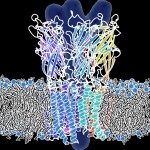Link to Pubmed [PMID] – 8196057
Link to HAL – Click here
Link to DOI – 10.1006/jmbi.1994.1366
J Mol Biol. 1994 Jun 3;239(2):249-75.
Understanding the relations between the conformation of the side-chains and the backbone geometry is crucial for structure prediction as well as for homology modelling. To attempt to unravel these rules, we have developed a method which allows us to predict the position of the side-chains from the co-ordinates of the main-chain atoms. This method is based on a rotamer library and refines iteratively a conformational matrix of the side-chains of a protein, CM, such that its current element at each cycle CM (ij) gives the probability that side-chain i of the protein adopts the conformation of its possible rotamer j. Each residue feels the average of all possible environments, weighted by their respective probabilities. The method converges in only a few cycles, thereby deserving the name of self consistent mean field method. Using the rotamer with the highest probability in the optimized conformational matrix to define the conformation of the side-chain leads to the result that on average 72% of chi 1, 75% of chi 2 and 62% of chi 1 + 2 are correctly predicted for a set of 30 proteins. Tests with six pairs of homologous proteins have shown that the method is quite successful even when the protein backbone deviates from the correct conformation. The second application of the optimized conformational matrix was to provide estimates of the conformational entropy of the side-chains in the folded state of the protein. The relevance of this entropy is discussed.

